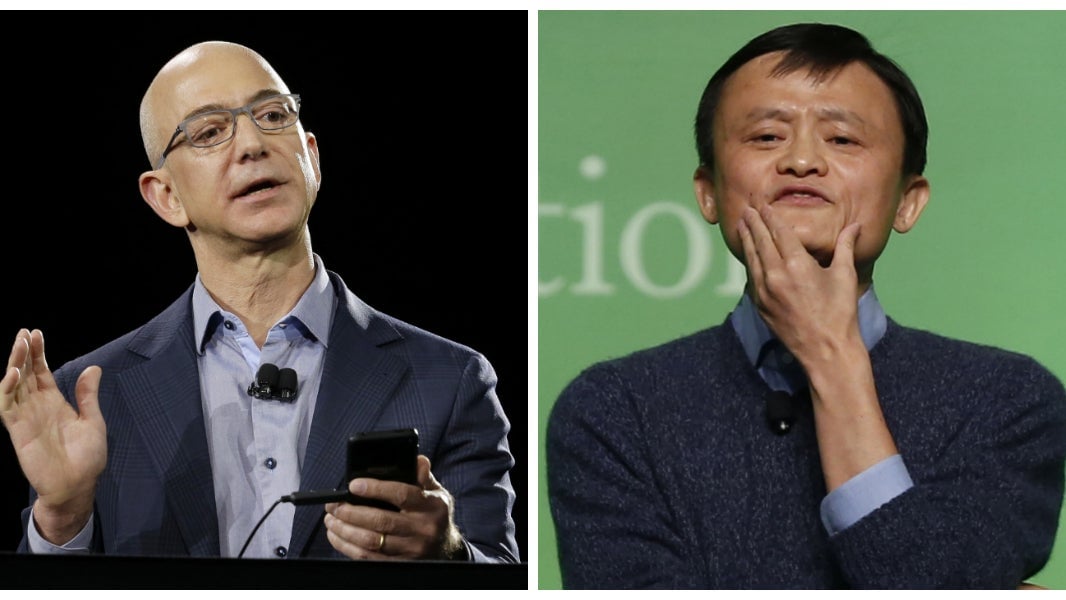Alibaba and Amazon are headed for an epic showdown in India
This post has been corrected.


This post has been corrected.
The world’s two largest e-commerce companies—America’s Amazon and China’s Alibaba—are poised to begin an epic battle for supremacy in one of the world’s fastest growing online retail market, India.
While Seattle-headquartered Amazon launched in India in 2013 and has made significant inroads since, Alibaba will start selling in India by August this year.
The Jack Ma-led Chinese e-commerce giant, however, won’t be rolling out its own platform in India. Instead, it plans to use Paytm, the Indian mobile wallet and e-commerce firm, where Ant Financial Services Group, an affiliate of China’s Alibaba Group, picked up a 25% stake for $575 million (Rs3,678 crore) earlier this year.
“We are looking at the legal and taxation issues for allowing sellers from Alibaba to sell through Paytm in India,” Amit Lakhotia, vice president for business at Paytm told Quartz. “We will be handling the logistics and are working on technology integration and figuring out how the returns will work.”
With that, Alibaba may finally begin to make its presence felt in a booming e-commerce market where the contest, so far, has been between homegrown firms like Flipkart and Snapdeal, and Amazon.
Alibaba’s plan
Under the technology integration that Alibaba and Paytm are working on, sellers would not have to separately list their products on Paytm, Lakhotia explained. Chinese sellers would be given the option to sell in India. If they choose to do so, Paytm will use Alibaba’s application program interface (API) to enable products listed on the Chinese portal show up on its website directly.
Last month, media reports suggested that, through its marketplace AliExpress, Alibaba would list 100 million stock keeping units (SKUs) on Paytm.
With Paytm handling the logistics, the target is to ensure that the shopping experience for Indian buyers of Alibaba’s wares will be no different from making purchases on any other e-commerce platform. “To a buyer it makes no difference whether the product is shipped from another state or another country,” Lakhotia said.
Head on
To be sure, this won’t be the first time that Alibaba and Amazon will go head to head. The two companies compete with each other in markets like Europe, but these typically have a more evolved e-commerce marketplace with a single dominant player.
E-commerce in the US is dominated by Amazon, in China by Alibaba, in Japan by Rakuten, while parts of Europe have a standalone local player with control over the market.
But India is different—and a massive opportunity: By 2030, the size of the e-commerce market here could grow from $20 billion currently to $300 billion.
“India is the only country where there are five companies competing for the same market in an ecosystem that is still evolving, and there is no dominant player as such,” said Arvind Singhal, chairman and managing director of Technopak, a retail consultancy.
That’s perhaps why Alibaba’s founder and executive chairman, Jack Ma, has visited India at least twice in the last seven months. Even when Indian prime minister Narendra Modi visited China earlier this month, Ma was rarely able to hide his enthusiasm. “We are excited about India. We are excited about Make in India and Digital India,” Ma said.
After all, with less than 15% of Alibaba’s business coming from outside its home market even after 16 years of operations, India could potentially be a big play for the Hangzhou-headquartered e-commerce giant.
Bezos’ play
Meanwhile, Amazon—which gets around 40% of its business from outside North America—has been gradually expanding its operations in India. Here it sells through Amazon.in, a marketplace operated by Amazon Seller Services, an affiliate of Nasdaq-listed Amazon.com.
The company has been competing closely with domestic majors like Flipkart and Snapdeal, which have a strong backing from marquee global venture capital firms.
And it hasn’t been shy of pouring in money. In 2014, just days after Flipkart announced its landmark $1 billion fund raising, Amazon said that it’ll invest $2 billion (Rs12,800 crore) in India.
Amazon has over 25,000 sellers on its India portal, compared to 30,000 on Flipkart, which is currently the largest online marketplace in the country in terms of gross merchandise volume (GMV), or the total sales that happen through a marketplace. Amazon India has 22 million products listed, and has 11 fulfilment centres across eight states in the country.
In two years, Amazon.in has touched a GMV of $2 billion, according to sources, which is nearly the same as Snapdeal, its other homegrown rival that started operations in 2010. Amazon India’s GMV is just about half of Flipkart’s $4 billion, although the website has been rated high in terms of customer satisfaction in several surveys.
Alibaba’s strengths around business-to-business (B2B) retail could, however, turn out to be a game-changer in the Indian market, as most existing players have either not ventured into B2B or made much headway.
With Amazon’s obsession with consumers and Alibaba’s fixation with small and medium enterprises, India’s growing appetite for online shopping should be well taken care of.
Correction: A previous version of this post incorrectly stated that Alibaba had bought a 25% stake in Paytm. The investment was made by Ant Financial Services Group, an affiliate of Alibaba Group.